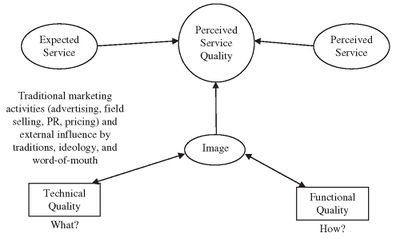Service quality model
| Service quality model |
|---|
| See also |
Service quality model describes how to achieve desired quality in services. Achievement of desired quality in services differs from tangible products, because the evaluation is based on expectations and attitudes more than data about reliability. There are multiple service quality models. The most popular are described below.
SERVQUAL model on managing service quality
SERVQUAL is a method to identify and solve problems related to quality of services. It was presented by A. Parasuraman, V. Zeithaml and L. Berry in 1988. The main idea is based on 5 gaps, which result in lower than expected quality of services. The method was one of the first tools created to evaluate and improve quality of services. Therefore, is became popular very soon.
The 5 gaps are:
- Expected service vs. management perception
- Management perception vs. Service design
- Service design vs. Service delivery
- Service delivery vs. Communication
- Expected vs. perceived service
SERVPERF model
SERVPERF (Service Performance) was created on basis of critique of SERVQUAL by J.J. Cronin and S.A. Taylor in 1994. They claimed that Parasuraman's study of relations between expected and experienced quality is not proper approach to quality assessment. The SERVPERF measures quality as an attitude, not satisfaction. However it uses an idea of perceived service quality leading to satisfaction. But it goes further, and connects satisfaction with further purchase intentions. The SERVPERF is a modification of SERVQUAL, and thus uses the same categories to assess service quality (RATER model).
RATER model
RATER model is an evolution of SERVQUAL method presented by A. Parasuraman, V. Zeithaml and L. Berry in 1988. The main idea is based on 5 gaps, which result in lower than expected quality of services. The authors proposed that the difference between expected and perceived quality should be evaluated in 5 dimensions:
- Reliability
- Assurance
- Tangibles
- Empathy
- Responsiveness
Grönroos model
Grönroos identified three dimensions of service quality: technical, functional and image. The model was shown on fig. 1.
- Technical quality - what customer receives as a result of interaction with the company, and which is important for him/her to evaluate the quality of service.
- Functional quality - how the customer gets the technical outcome, which includes: communication, competence, staff, etc.
- Image - builds up through technical and functional perfection.
The model is a good measurement tool for quality of services assessment. However the relationship between perceived quality and customer satisfaction and above mentioned dimensions is not clear.
Gummesson model
Gummesson proposed a model in which quality of service consists of perceived quality and satisfaction. Based on Grönroos model he described four dimensions of quality:
- Designed quality
- Product quality
- Delivery quality
- Relational quality
Importance-Performance model (Martilla & James)
Importance-performance analysis has been proposed by Martilla and James in 1977. The model shows results of quality evaluation on grid where one axis is Performance and the other - Importance. The evaluation depends on the quadrant in which the elements of the service will be shown. There are four possibilities:
- Quadrant 1. high performance, high importance - keep up the good work
- Quadrant 2. high performance, low importance - possible overkill
- Quadrant 3. low performance, low importance - low priority
- Quadrant 4. low performance, high importance - concentrate here
References
- Cronin Jr, J. J., & Taylor, S. A. (1994). SERVPERF versus SERVQUAL: reconciling performance-based and perceptions-minus-expectations measurement of service quality. The Journal of Marketing, 125-131.
- Grönroos, C. (1984). A service quality model and its marketing implications. European Journal of marketing, 18(4), 36-44.
- Oh, H. (2001). Revisiting importance–performance analysis. Tourism management, 22(6), 617-627.
Author: Slawomir Wawak
